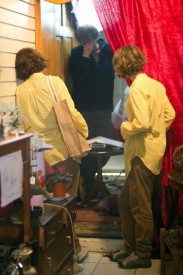Several weeks ago I evaluated Stop/Eject’s shooting schedule. As noted in that post, we got behind schedule more than once during production. Today I want to look at the reasons why, so I can remind myself next time I draw up a schedule, and so that you lovely readers can perhaps pre-empt similar problems on your own projects.
-

Self shooter. Photo: Paul Bednall Lack of a First Assistant Director. The key role of this crew member is to keep things running to schedule, and we didn’t have one. Two people were lined up and then dropped out due to paying work, and no other applicants were forthcoming. Difficult to see what could have been done to avoid this, other than raising more money to pay everyone.
- Lack of a separate Director of Photography and Camera Operator. I chose to act as my own DP on Stop/Eject and, when operator Rick Goldsmith was only able to do half of the shoot, chose not to find a replacement for the remainder and fill that role myself as well. This is something I’ve done on many of my previous productions, so I knew full well that it wasn’t a good idea; it slows things down and it reduces the time I can spend working with the actors. But I did it anyway because I figured any DP worth their salt would balk at the pathetic equipment we had available.
-

Steve Giller assembles the alcove. Photo: Paul Bednall Lack of other skilled crew. There were only two people on the crew who were really handy with power tools, Col and Steve Giller, and Steve was only around for a couple of days. So when we arrived at a new location and had to assemble the alcove set and rig lights from the ceiling, there were only one or two people doing these two most time-consuming tasks. Solution: ask around in pre-production for DIYers who fancy helping out on a film.
- Large number of costume changes. With eleven story days and a lead actress playing two different versions of her character, there was a lot of costume swapping, each one accompanied by a hair and make-up change too. I’d advise you to always try to minimise the number of story days in your script, and to carefully schedule your shoot to reduce the number of switches.
-

Hair and make-up changes take time. Photo: Katie Lake Large number of locations. Even though we found several locations in one building, there was still a lot of moving around, which wastes huge amounts of time. Ideally you should shoot in only one location each day.
- Fatigue. As mentioned in my earlier post, scheduling long days and/or wrapping late gets you into a destructive cycle because your cast and crew work slower the next day due to lack of sleep.
- Composition issues. This is an odd one which nobody foresaw. We shot in the Cinemascope aspect ratio, 2:35:1, which is a very wide frame, but we had many scenes set in the alcove, which was a tall, narrow set. Think about how wide a 2.35:1 shot has to be to see the head of a standing actress and a tape recorder on a two foot high table at the same time, and how much will be revealed at the sides of frame. Combine this with the fact that some alcove scenes were shot in a corridor at the back of the shop location that was only half the width the alcove was meant to be, so one wall always had to be out of frame. And then factor in that you can’t compress the vertical space by going for a high angle shot because then you won’t see the face of the actress as she looks down at the recorder, and you can’t compress it with a low angle shot because you’ll reveal the lights hanging from the ceiling. Yes, it was a nightmare shooting in that little alcove. There was a lot of time wasted in scratching my head over how to cover the scenes effectively while framing out the wall and the lights. This might seem like a very esoteric problem, but I can derive three points of good general advice from it:
-

Alcove headaches. Photo: Paul Bednall Think carefully when choosing the aspect ratio for your film. Consider the shape and size of your key locations and props. When making The Dark Side of the Earth‘s pilot, DP Oliver Downey pointed out that the tall, spindly Swordsman puppet and the tall training room set were not well suited to the 2.35:1 anamorphic ratio we were shooting.
- Think twice before rigging lights to the ceiling. This is very much a double-edged sword. Although it takes a long time to hang lamps from the ceiling, once they’re up there you will find it relatively quick to light each of your set-ups. But if you then realise that the ceiling’s going to be in shot, taking those lamps down or altering your composition to frame them out could be a big time-waster.
- Small locations will slow you down. Working in a confined space with lots of lamps, grip and mics is slow, hot and unpleasant. Avoid it wherever possible. More space means lights can be quickly set up on stands further away, rather than having to be rigged time-consumingly to walls or furniture.
-
So those are the main things that slowed down Stop/Eject, and of course there are many, many other things that can hold you up when shooting. And although many of these are impossible to foresee or prevent, a little thinking time in pre-production can identify a lot of these issues and help you plan accordingly.